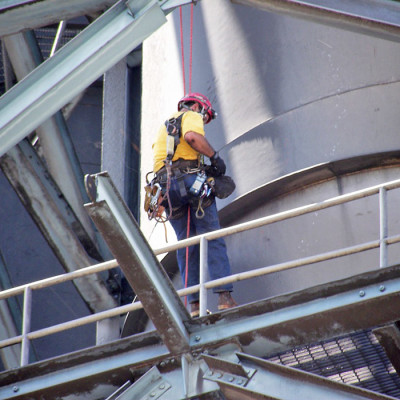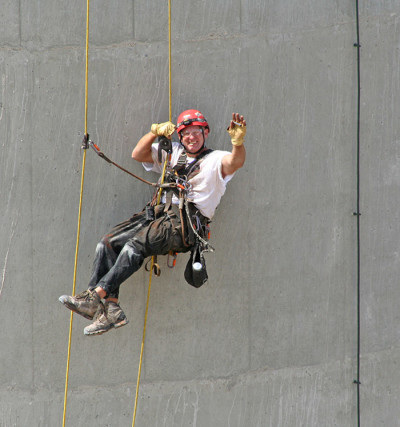 Any tall industrial structure presents a challenge when it comes to inspection, maintenance, and repairs. Industrial chimney inspections are a critical maintenance task that should be performed regularly to prevent expensive repairs. Many companies that use more traditional means of access like cranes or scaffolding are not equipped the quickly and efficient tackle inspection & testing services like a rope access crew. Rope access methods allow our chimney experts to perform stack & chimney inspections on a compressed schedule and within minimum budget limits. These are just a few advantages of using rope access for industrial chimney inspections.
Any tall industrial structure presents a challenge when it comes to inspection, maintenance, and repairs. Industrial chimney inspections are a critical maintenance task that should be performed regularly to prevent expensive repairs. Many companies that use more traditional means of access like cranes or scaffolding are not equipped the quickly and efficient tackle inspection & testing services like a rope access crew. Rope access methods allow our chimney experts to perform stack & chimney inspections on a compressed schedule and within minimum budget limits. These are just a few advantages of using rope access for industrial chimney inspections.
The main benefit of utilizing rope access for inspections and testing is really the safety and speed with which workers can get to or from difficult locations. Because rope access equipment is rigged at the top of the structure, an inspection can be done with minimal impact on other operations in the facility. There is little to no downtime which can harshly affect production schedules.
If you are wondering why rope access remains the best choice for smokestack & industrial chimney inspections, check out the following:
Accurate Inspection Results
For safety inspections that are needed as a precursor to structural repair work, extremely accurate inspection results are imperative to determine expected maintenance costs & time commitments. Even thorough industrial chimney inspections that are performed to determine condition and stability of a structure require accurate inspection results to help avoid breakdowns, outages or worse. Rope access allows technicians to examine every inch of the structure to accurately estimate the cost & time of repairs or maintenance needed. Companies who offer “binocular inspections” will only be able to identify major issues. With an extended level of access to every component of a structure, rope access can ensure that every element is covered in a thorough inspection.
By hiring a rope access service company first, facility managers can ensure that their safety inspection is done accurately the first time. Rope access technicians are able to determine if small visual problems spotted from the ground are in fact bigger, underlying issues that require attention immediately.
Cost
Comparatively, rope access is a more affordable option than scaffolding or other means of access like cranes or lifts. Rope access requires less equipment and crew members which help to eliminate costs. Plus, rope access is quicker to set up and reduces wasted time on construction. When a company chooses to use scaffolding, operatives must erect the structure before they can start work. Time equals money and the longer a scaffolding team stays on the job, the more money will be lost. Plus, the cost of supplying the scaffolding also increases the price of choosing this method. In the end, the combined cost of scaffolding will outweigh the cost of simply hiring a small team of rope access technicians. The same goes for heavy machinery, which may not even be an option if space is tight or limited within the facility itself.
Speed
 There is no doubt that rope access for industrial chimney inspections and testing services is the fastest means of access. Rope access rigging and equipment can be set up in a matter of minutes to a few hours depending on the location and structure layout. Rope access also does not need permits like scaffolding equipment often requires. Utilizing innovative rope access methods means you can avoid delays that are common with other types of access.
There is no doubt that rope access for industrial chimney inspections and testing services is the fastest means of access. Rope access rigging and equipment can be set up in a matter of minutes to a few hours depending on the location and structure layout. Rope access also does not need permits like scaffolding equipment often requires. Utilizing innovative rope access methods means you can avoid delays that are common with other types of access.
Safety
Any work at height can seem perilous, but rope access is actually the safest means of industrial chimney inspections. Safety statistics for the rope access industry are superior to other methods like scaffolding, which is extremely important to any work environment. Technicians are rigged to two separate ropes, one acting as a fail-safe should the main line break, and the tools they used are also tethered to them so that passersby can remain safe should a tool slip while in use. IA technicians are all SPRAT certified and each crew member must meet rigorous standards and pass tough evaluations that will ensure they are fully prepared for performing work at height safely and efficiently.



